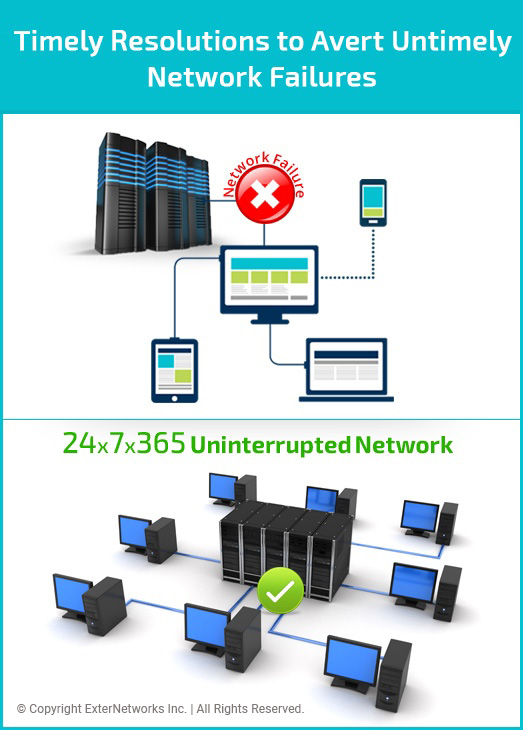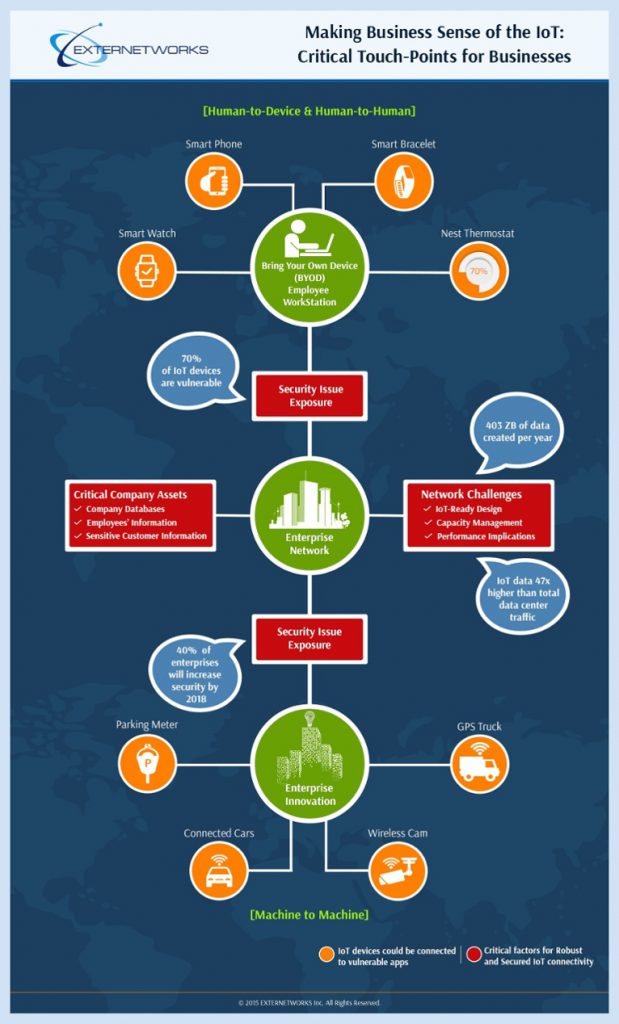Timely Resolutions to Avert Untimely Network Failures!
Has your network ever experienced untimely network failures? Such untimely network failures can leave any organization, and especially the IT Manager, highly frustrated and helpless. Such failures make you realize how little control you actually have over your own network, when you just don’t know what will fail and when, how long will it take to solve the issue and will the network run smoothly later?
There are all sorts of frequent problems that can arise from the network perspective and without your realizing it, these network problems will have a direct business impact and will adversely affect the day-to-day activities of your business. Some organizations in certain industry sectors may be able to foresee this business impact of network failures more clearly than others. It is the IT Manager who has to bear the brunt of these network failure impacts, when he is pressurized by other business functions that require and depend upon the smooth running of the network 24x7x365.
As the IT Manager, you are responsible for the pre-emptive and proactive monitoring, identification and resolution of network issues to prevent untimely network failures that may cost a business heavily in terms of lost revenues and brand image. See how partnering with a Managed NOC can help…

Avert untimely network failures and ensure uninterrupted network service through the right Managed Service Provider (MSP)
Many organizations today are leveraging applications as revenue-generating tools. This increased dependence on network applications has greatly increased the business impact of network issues and their untimely identification and delayed resolution.
The IT Manager faces the complex task of managing the network and ensuring the proactive detection of network issues, which require a lot of resources and time, and is a highly challenging task. Business operations and its performance can be greatly hindered by delayed detection of network issues. Thus, there is a need for companies to ensure network issues are responsively managed and systems downtime, which could cost a company loss of revenues, is kept to a minimum. In this blog, we would learn how network issues have a direct impact on your business activities and how the modern day NOC can help you to proactively manage your network issues, so that you are guaranteed 100% service uptime cost efficiently.
Managed NOC: Managed Service Providers or MSPs, as they are popularly known, offer services such as the modern day NOC. A Managed NOC service is designed to work as an extension of your organization’s IT infrastructure. MSPs can provide a seamless experience of managing the NOC and carry out the full range of NOC tasks such as monitoring, detection, isolation and resolution of network issues impacting network as well as business performance. MSP’s Network Operations Center (NOC) carries out proactive around-the-clock server and service monitoring. In order to ensure 100% network service uptime and uninterrupted business operations due to network downtime, MSPs work with remote monitoring and advanced management tools.
Let’s look at how Managed NOC can help you keep up with the challenges of timely identification of network issues to avoid the business impact of network failures.
Business Impact of Network Issues
Most organizations fail to realize and even calculate the business impact of network performance issues. It is crucial that you realize this business side of the impact that your network has on your business, apart from the technological impact.
Let us now look at some of the challenges that businesses face in understanding the business impact of network performance and issues.
Inability to measure the quality of end-user experience
Most organizations measure the performance of their network and applications based exclusively on the uptime and the average speed. However, these metrics do not measure the performance of the network and applications from the users’ perspective, but only from the IT perspective. Organizations should, hence, aim to connect between the IT department and business users by deploying capabilities that allow them to measure application performance from the end-user’s perspective.
Difficulty in calculating ROI from deployment of network and application performance management solutions
Many organizations fail to invest in network and application performance management solutions because they are incapable of conducting a cost-benefit analysis and calculating the Return-on-Investment (ROI) for investing in such solutions that would allow them to resolve network and application issues. Such organizations are unable to calculate the opportunity cost and how such investments will benefit their bottom-line. This inability to calculate the ROI delays taking actions to improve their network and application performance, which leads to dropped earnings, cost savings, and brand image.
Difficulty in calculating business impact of performance issues in B2B and B2C environments
The calculation of the business impact of network and application performance issues is directly influenced by the nearness of the application users to the revenue source. Generally, it is easier to understand the business impact of applications that are being used in business-to-consumer (B2C) environments. In such B2C environments, these applications are used as revenue-generating tools. Hence, it is crucial that you should be able to not only understand, but also calculate the business impact of your network and applications by monitoring the performance of these applications as well as investing in performance optimization.
Loss of revenue due to delay in response times and network failures
In organizations that make use of web applications, research has indicated that such organizations could lose a substantial part of their revenues due to even one additional second of delay beyond the defined baselines for such applications. Research has also found that users wait for a maximum of 4 to 6 seconds before they give up and move on to the next website in their search. Also, if your website is slower than a user’s expectation, he is less likely to move closer to a check-out or registration page. All this not only greatly reduces the sign-up of new customers, but also adversely affects your organization’s brand image and customers’ perception of your brand.
Lack of ability of mapping application usage to supported business processes
Most network and application management solutions can successfully monitor uptime and speed of applications. However, another important aspect that they may fail to measure is how the performance of these applications are connected to the business processes that they support. When organizations are able to map the application usage to the supported business processes, then they can improve employee productivity, accelerate workflows and streamline key business processes by measuring the business impact of network and application performance issues.
Inability to repair network and application issues in a timely manner
Many organizations do not possess the ability to identify and resolve network and application issues in a timely manner. Organizations should deploy solutions that allows them to resolve network and application issues in a timely manner by delivering the necessary information to the right people at the right time.
Related Post: Business Continuity Through Managed Network Services (MNS) How Managed NOC Helps Address Business Impact of Network Issues?
Let us now look at how Managed NOC can help in the timely resolution of network issues to effectively address the challenges of business impact on it.
Segmentation of application response times into server, network, and application delay
Many organizations are unable to find out if their performance issues are induced by network, server or application related problems. When end-users complain about performance issues, your Managed NOC can help you understand what parts of the enterprise infrastructure are causing these problems and identify the root causes of such performance issues. Your Managed NOC also helps you make informed decisions about actions required to resolve performance issues in a timely manner.
Help transform network and application performance metrics into business metrics
Your MSP can help you monitor and evaluate your network and application performance, and help transform performance metrics into business metrics such as conversions, customer satisfaction, employee productivity, and page views.
Your Managed NOC can help provide executive dashboards that will allow operations and business personnel to correlate IT metrics such as response delay times, network uptime, page load times, etc., to business metrics.
Evaluate network performance from an end-user’s perspective
A Managed NOC can help you measure the business impact of your network issues, as it helps you monitor your network performance from the end-user’s perspective. Whenever there is a network issue, managed service provides your organization the ability to determine the number of users who are being impacted by the issue and also helps you realize the impact of network issues on various other supported business functions.
Reduction of business impact of network issues and failures
A Managed NOC can help reduce the business impact of network issues and failures by minimizing their occurrences. It also helps to proactively monitor, identify and resolve any issues, and also deal with and resolve unanticipated issues as a top priority. An MSP can help take complete care of all aspects of your network management such as security, data protection, applications and hardware.
It also helps to manage your network, so that it functions in a stable and reliable manner by optimizing your network’s performance, ensuring it works at its maximum efficiency and reliability levels.
Benefits of Managed NOC for Proactive Network Management
Managed NOC helps provide many benefits for using it for proactive monitoring, identification, resolution and management of network issues, before they impact your business. It also offers several other benefits such as:
- Enhanced Productivity: Managed NOC helps minimize the business impact of IT failure through continuous oversight of your network. It helps increase productivity through 100% guaranteed network service uptime by reducing the time period from network failure to issue resolution.
- Proactive Resolution of Network Issues and Failures: An MSP can help in early and timely identification of imminent issues, before they affect your network and your employees’ productivity.
- Reduced Business Impact from IT Failures: Managed NOC helps your network operate in a stable and reliable manner through continuous preventative maintenance and remote monitoring, which results in proactive resolution of network issues that could impact your business.
- Your Own Dedicated NOC Department: An MSP will provide you with your own experienced NOC team to implement the right network systems and recommend ways to use your network capabilities to its fullest capacity, and help your business grow.
- Reduced Network Downtime Through Proactive Maintenance: Managed NOC greatly reduces the number of untimely and sudden network failure incidents you run into through regular, preventive maintenance activities that are designed to keep your network operating efficiently.
- Allows You to Focus on Core Competencies: A Managed NOC can help you leave all your network worries to the MSP, and instead spend your time and efforts on your core business activities.
ExterNetworks is a single-source provider of Managed Technology Services that seamlessly delivers IT services by providing you access to experienced resources with specialized skills. Our services include deploying and managing NOC services for a broad range of applications, technologies and enterprises. We implement a full range of NOC tasks such as proactive monitoring, detection, isolation and resolution of network issues impacting your business and its processes. Proactive analysis allows to identify potential network issues, before they become problematic and cause untimely network failures. We also help to improve service levels by quickly identifying the root cause of incidents and initiate maintenance based on advanced diagnostic tools.









